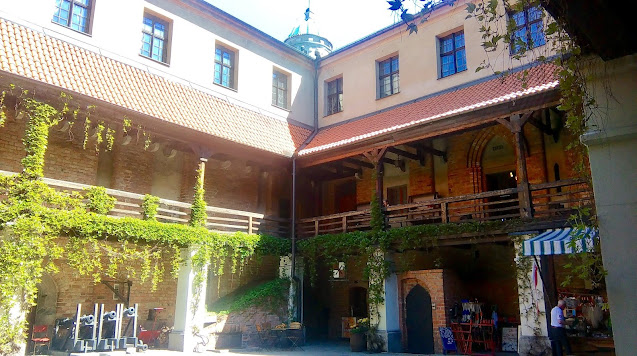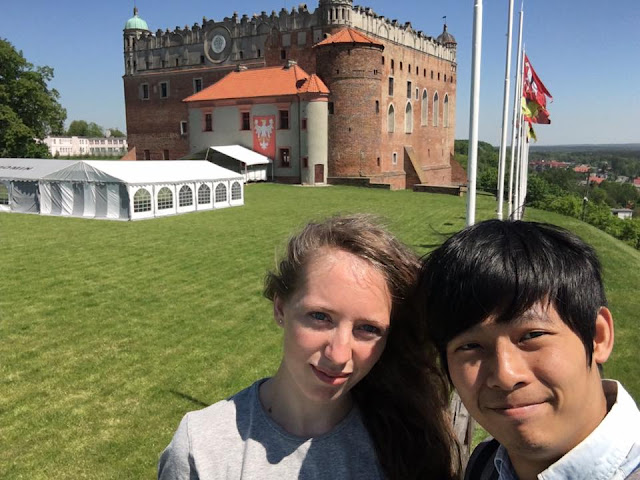Golub Castle is a four-wing conventual Teutonic castle built in the 13th/14th century. It was constructed on a hill to overlook the entire town of Golub-Dobrzyń. The castle was initially built in a brick Gothic architectural style in 1293 or 1300. During the reconstruction in 1616-1623, a Renaissance attic was added. Today, the castle houses a museum, hotel, and restaurant.
According to legends, during the Polish-Swedish wars, Golub Castle had a secret underground passage near Drwęca that connected it to Radziki Duży Castle. When the Swedes occupied Golub, the townspeople escaped through this passage, and the invaders were trapped when a large stone fell into the river, collapsing the tunnel. The stone can still be seen in the Drwęca stream.
Before the castle's construction, there was a wooden stronghold guarding the crossing over the Drwęca River. In 1293, it was exchanged between the monastic bishop of Włocławek and the Teutonic Order. From 1300 to 1311, a peripheral wall of the upper castle and two wings (west and south) were built to serve as the residence of the Teutonic commander. These works are associated with the involvement of Prussian national champion Konrad Sack, and the castle was likely designed by the same architect as Rogoźno Castle. In the following phase after 1330, the north-west corner tower was constructed. The castle faced capture attempts by Władysław Łokietek three times between 1329 and 1333. The southern wing contained a chapel dedicated to St. Cross, accompanied by penitential cells, the chapter house, and the infirmary. The west wing was occupied by the commander, while the north wing housed the dormitory for religious brothers. The east wing contained the sacristy, refectory, and other rooms.
To the east of the castle, a fortified bailey with towers was constructed, which housed stables, barns, and granaries. From 1409 to 1411, the castle hosted some of the religious troops gathering for the Battle of Grunwald. During the battle, Commander Nicolaus Roder was among the two hundred knights killed. In 1410, the castle was occupied by Polish knights and then handed over to Niemście from Szczytniki by King Władysław Jagiełło. However, the castle was soon reclaimed by the Teutonic Knights with the support of the Order of the Sword Knights. This led to opposition from Polish troops. In autumn 1410, under the leadership of Bydgoszcz staroste Dobiesław Puchała of the Wieniawa coat of arms, the Polish forces defeated the majority of the Livonian army in a battle near Golub. After the signing of the first peace treaty of Toruń in 1411, the castle was returned to the Teutonic Knights.
During the Golub War in 1422, the Polish army captured the city after artillery fire from 14 cannons. The castle was severely damaged due to the artillery shelling. After the Teutonic Knights recovered the castle, two Polish prisoners of war were imprisoned there. In the summer of 1423, the prisoners escaped from the castle, as documented in a letter from the Toruń commander. Subsequently, the castle's defense system was adapted to withstand firearms. Two cylindrical towers were built in the outer ward and connected by a bridge with defensive porches. The castle was rebuilt between 1433 and 1449 following the destruction.
At the outbreak of the Thirteen Years' War in1454, the castle came under the control of the Prussian Union forces, acting in consultation with Poland. On September 19, 1460, the castle was besieged by the mercenary Teutonic army led by Bernard Szumborski. However, the Polish castle crew, commanded by Andrzej Puszkarz, successfully repelled the attack. Although the Teutonic Knights captured the city of Golub, they were unable to conquer the castle for two years.
Between 1616 and 1623, the castle underwent a reconstruction ordered by Princess Anna Wazówna, the sister of King Zygmunt III Waza, who had become the owner of the Golub starosty. The reconstruction included the addition of late Renaissance attics, a building in the foregate, changes to the windows, and the installation of turrets in the corners. It was during this time that tobacco was grown for the first time in Poland, imported from Turkey. The castle was destroyed in 1655 during the Swedish wars, but its interiors were renovated at the beginning of the 18th century. In 1920, the Polish authorities established a museum in the castle, and in 1937, the roof and several rooms were renovated.
After the war, the castle underwent security work between 1947 and 1953. It was rebuilt and restored from 1959 to 1966 and during subsequent adaptation works after 2006. In 1977, Golub Castle was the site of one of the first historical reconstructions in Poland, featuring a knights' tournament. Today, it remains a prominent historical and cultural attraction, offering visitors a museum experience, as well as hotel and restaurant facilities.



















0 komentarze:
Post a Comment